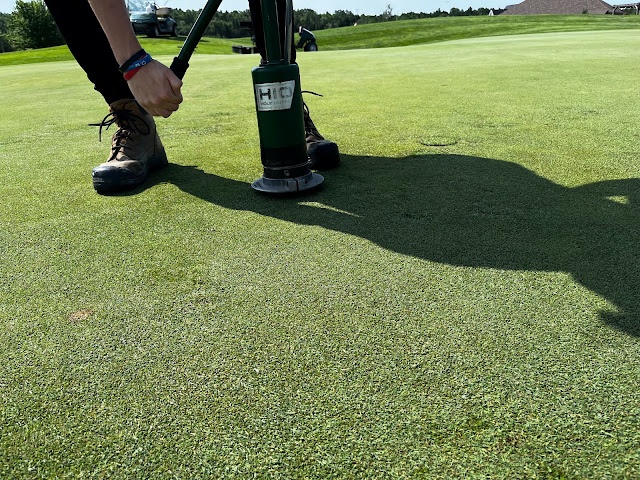Hey Folks,
Hope all is well with you folks and the winter hasn't treated you too poorly. By historical standards its been a fairly benign winter with not to much snow and relatively warm temperatures. There were a few concerning ice developments early in the winter, where I was sure it would be a problem, but mother nature changed the course of events and the ice abated.
Each year we try to reduce the the amount of ice on the course, utilizing a number of different methods. The black "inca" mats are an example of the one of the newer items we have been trying out. The mat is actually a device used to reduce erosion on steep slopes. The mat is made up of expand plastic and is designed to hold topsoil during the seeding process. In our application it is laid on the surface of the green to interfere with ice development. Because its black in color, fibrous and water can travel easily through it, ice breaks up rather quickly around the mat.
 |
| Number 18, where we normally have ice issues. |
One draw back to these mats is the expense. To cover the all of the green would be extremely expensive, especially where we are still proving their value. In the mean time we are using them in areas where we traditional have ice issues. This year hasn't really been what we would call a "tester" but we will mark the results and keep working the problem.
Another device we been trying this year are a incorporation of drain elevators in to the green profile. Water can often get trapped on the green when a topsoil collar swells with frost but the sand green remains at the same height. This is referred to as "collar damming" and can result in ice patches growing larger as the winter progresses. Here's some information about greens that is pertinent to the problem.
Our greens are built using the same specification. A cavity is created in the natural subsoil that mirrors what the expected green surface to be. In that cavity herring bone drainage is added below the surface and exits the green to a convenient out-fall. The drainage is covered with pea stone and then the whole cavity is filled with USGA spec sand. This creates a uniform layer of sand over the whole area of the green where the water can exit when the sand is filled. In the winter the surface of the green freezes and the water can't find its way to the drainage. Water freezes - ice forms - kills grass - temporary greens - grumpy members....etc. To help combat this process we have adopted the following steps.
 |
| Using a metal probe we locate the subsurface drainage on the green where water typically puddles. |
 |
| The we take a hole changer, remove the depth gauge and auger a hole down the drainage pipe. |
 |
| We continue this until we find the "pea stone" and pipe. The hole is cleared of debris. |
 |
| Then using a hex plugger we widen the mouth of the hole. |
Again, the winter wasn't really a test of these devices, but where we have implemented new practices will measure the results and continue to prove and improve the process.
On Monday we pulled some samples from the greens and brought them back to the shop to warm up. Keep in mind the samples are small portions of large areas so the information produced is finite but at this point the results are great. The samples were taken from the historically poorest performing areas, here are some photos of their progress.
 |
| The samples pulled from the green on day one. |
 |
| Day three. The bottom right plug is from 3 green, the last green to clear of ice. |
 |
| And finally today, 5 days later. Every thing is growing well. |
The recent snow should not have any serious detrimental effects on the golf course health. There is slight chance of diseases showing up with the snow coverage and wetness, but the environment should change quickly, preventing any real damage. Now that the ice is all gone, we're actually happy to see the snow coverage, as it shelters the turf from any wild temperature swings.
As far as an opening date for the golf course, please don't expect any miracles. At this point it looks like it could be an early start to the season but a lot boxes have to checked before that can happen. Rest assured we will open as soon as humanly possible, with a balance for length of season and health of the golf course in mind. I'm optimistic. Stay tuned!!










.JPG)











.JPG)



















